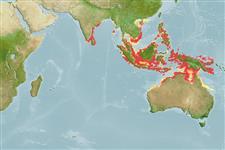Environment: milieu / climate zone / depth range / distribution range
Écologie
marin; eau douce; saumâtre; profondeur 0 - 50 m (Ref. 189). Tropical; 21°N - 26°S, 76°E - 153°E (Ref. 189)
Indo-Pacific: Indian Ocean (Sri Lanka and India) and western Pacific (Java, Sulawesi, Timor, Ambon, the Philippines and northern Queensland). Presumably more widespread in the Indian Ocean, but not previously separated from Thryssa baelama.
Taille / Poids / Âge
Maturity: Lm ? range ? - ? cm
Max length : 10.7 cm SL mâle / non sexé; (Ref. 189)
Épines dorsales (Total): 0; Épines anales 0; Rayons mous anaux: 24 - 28. Almost identical to T. baelama except in the following: 1 or 2 keeled scutes without arms immediately behind the isthmus, first and second supra-maxilla relatively longer, tip of maxilla blunter and perhaps not always reaching to front border of pre-operculum; also, fewer branched anal fin rays and fewer ;re-caudal but more caudal vertebrae (Ref. 189).
Its habitat and biology is probably similar to T. baelama, but not separated from it in previous records.
Life cycle and mating behavior
Maturité | Reproduction | Frai | Œufs | Fécondité | Larves
Wongratana, T., T.A. Munroe and M. Nizinski, 1999. Order Clupeiformes. Engraulidae. Anchovies. p. 1698-1753. In K.E. Carpenter and V.H. Niem (eds.) FAO species identification guide for fishery purposes. The living marine resources of the WCP. Vol. 3. Batoid fishes, chimaeras and bony fishes part 1 (Elopidae to Linophrynidae). FAO, Rome. (Ref. 9822)
Statut dans la liste rouge de l'IUCN (Ref. 130435)
Menace pour l'homme
Harmless
Utilisations par l'homme
Pêcheries: intérêt commercial mineur
Plus d'informations
Noms communsSynonymesMétabolismePrédateursÉcotoxicologieReproductionMaturitéFraiRassemblement de ponteFéconditéŒufsDéveloppement de l'œuf
RéférencesAquacultureProfil d'aquacultureSouchesGénétiqueElectrophoresesHéritabilitéPathologiesTraitementNutrientsMass conversion
CollaborateursImagesStamps, Coins Misc.SonsCiguateraVitesseType de nageSurface branchialeOtolithesCerveauxVision
Outils
Articles particuliers
Télécharger en XML
Sources Internet
Estimates based on models
Preferred temperature (Ref.
123201): 27.3 - 29, mean 28.4 °C (based on 538 cells).
Phylogenetic diversity index (Ref.
82804): PD
50 = 0.5000 [Uniqueness, from 0.5 = low to 2.0 = high].
Bayesian length-weight: a=0.00437 (0.00186 - 0.01024), b=3.11 (2.93 - 3.29), in cm total length, based on LWR estimates for this Genus-body shape (Ref.
93245).
Niveau trophique (Ref.
69278): 3.3 ±0.5 se; based on size and trophs of closest relatives
Résilience (Ref.
120179): Haut, temps minimum de doublement de population inférieur à 15 mois (Preliminary K or Fecundity.).
Fishing Vulnerability (Ref.
59153): Low vulnerability (10 of 100).
